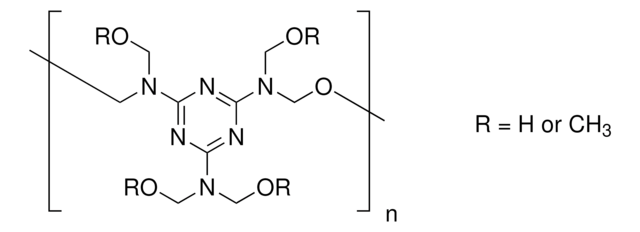Alle Fotos(1)
Wichtige Dokumente
LB5
Latex beads, polystyrene
0.46 μm mean particle size
Anmeldenzur Ansicht organisationsspezifischer und vertraglich vereinbarter Preise
Alle Fotos(1)
About This Item
Empfohlene Produkte
Form
aqueous suspension
Zusammensetzung
Solids, 10%
Verpackung
pack of 1 mL
pack of 15 mL
pack of 2 mL
Mittlere Partikelgröße
0.46 μm
Suchen Sie nach ähnlichen Produkten? Aufrufen Leitfaden zum Produktvergleich
Allgemeine Beschreibung
Polystyrene microparticles are negativelycharged- stabilized colloidal particles. These microparticles are synthesizedby the polymerization of styrene under conditions that produce coalescent beadformation. Polystyrene latex beads have a broad range of applications such as cellcounter calibration, antibody-mediated agglutination diagnostics, electronmicroscopy, and phagocytosis experiments.
Anwendung
Polystyrene latex beads have been used as a component of an artificial device to draw blood from mice. It has also been used as a component of the protein-free latex meal for the extraction of the peritrophic matrix (PM) from female Anopheles gambiae.
Hier finden Sie alle aktuellen Versionen:
Besitzen Sie dieses Produkt bereits?
In der Dokumentenbibliothek finden Sie die Dokumentation zu den Produkten, die Sie kürzlich erworben haben.
Kunden haben sich ebenfalls angesehen
Presence of chitinase and beta-N-acetylglucosaminidase in the Aedes aegypti: a chitinolytic system involving peritrophic matrix formation and degradation
Benedito P D F, et al.
Insect Biochemistry and Molecular Biology, 32(12), 1723-1729 (2002)
Joanna Koziel et al.
PloS one, 4(4), e5210-e5210 (2009-04-22)
It is becoming increasingly apparent that Staphylococcus aureus are able to survive engulfment by macrophages, and that the intracellular environment of these host cells, which is essential to innate host defenses against invading microorganisms, may in fact provide a refuge
Je-Wen Liou et al.
PloS one, 6(5), e19982-e19982 (2011-05-19)
Recent research shows that visible-light responsive photocatalysts have potential usage in antimicrobial applications. However, the dynamic changes in the damage to photocatalyzed bacteria remain unclear. Facilitated by atomic force microscopy, this study analyzes the visible-light driven photocatalyst-mediated damage of Escherichia
Unser Team von Wissenschaftlern verfügt über Erfahrung in allen Forschungsbereichen einschließlich Life Science, Materialwissenschaften, chemischer Synthese, Chromatographie, Analytik und vielen mehr..
Setzen Sie sich mit dem technischen Dienst in Verbindung.




